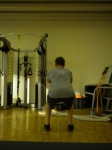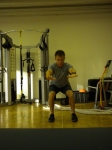Are you self aware of your body? Most of us don’t understand that what you tolerate you accept, but it is reality. Think about it for a minute. You get used to the way you feel and consider it to be normal. My dad tells me he has knee pain, back pain. He says the pain is part of life and you learn to deal with it. Tolerate it! I disagree. Many of our bodies are locked. The joints and tissues have aged and begun to lose integrity.
One reason the joints are locked is due to fascial restrictions. Fascial restrictions often occur in response to injury, disease, inactivity, or inflammation (stress or poor diet), causing fascial tissue to lose elasticity and become dehydrated. When fascia loses its elasticity and becomes dehydrated, fascia can bind around the traumatized areas, causing a fibrous adhesion to form. Fibrous adhesions are known to be painful, prevent normal muscle mechanics (i.e. joint range of motion, muscle length, neuromuscular hypertonicity, and decreased strength, endurance and motor coordination) and decrease soft-tissue extensibility. In other words, you get tight, lose flexibility, and decrease muscle efficiency. In time, the lack of proper joint mechanics will takes its toll on the body causing pain and structural dysfunctions.
What do you do about it? There are many treatments plans to choose from. I’d like to mention what works for me and many of my clients, use of a roller. Foam rolling is a form of fascial tissue release. Most foam rollers are just a basic foam cylinder, others are more dense and have PVC pipe wrapped with a rubbery cushion. You can also use a tennis ball, racquet ball, or lacrosse ball. It all depends on what the individual person can handle with regards to tenderness.
One of my clients walked in the other day while I was rolling on the roller. She says, “Are you in pain?” This is a typical question I get from time to time. Think of using the roller as preventative maintenance. It is not just for rehabbing an injury or reducing the symptom of pain. Breaking up the knots on a regular basis will not only prevent injury but will allow you to have more efficiency during your training. This efficiency will be increased strength, improved range of motion, and enhanced force production. I recommend using this fascial release technique prior to any sporting activity, workout session, and first thing in the morning upon waking. The last one especially if you are a bit older and your joints have been locked up for quite some time.
I’ll link a video or two below for those of you who haven’t used one before. You can purchase a roller online or at your local sporting goods store. I’d start by focusing on rolling the major joint areas. These include the hips and glutes, upper back areas and shoulders. Also, I’d suggest rolling out the lower leg and calf region. You can find many videos on foam rolling via Youtube. Add rolling as a supplement to your flexibility program.





